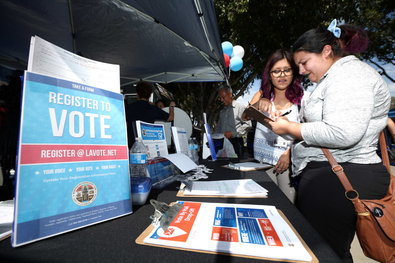
How to Energize Demoralized Voters
This year’s presidential campaign is one of the most contentious of all time. But all the heat has created little light for many Americans, particularly with two unpopular candidates. Many people are fed up. The percentage of people who say they are likely to vote is quite depressed, particular among young people, only 47 percent of whom say they will definitely vote for president. What can be done to get more Americans to the polls?
* energize = 열기[열정/활기/기운]를 돋우다/ demoralized = 사기가 저하된/ contentious = 논쟁이 많이 벌어지는/ particulaly = 특히, 특별히/ fed up (with ~) = 지긋지긋한, 신물난/ vote for ~ = ~에 투표하다/ the polls = 투표소
 더 많은 미국인을 투표소로 이끌려면 무엇을 해야 하나요?
더 많은 미국인을 투표소로 이끌려면 무엇을 해야 하나요?
1. Absentee Voting and Same-Day Sign-Up
The legal hurdles to registering and voting are substantially greater in the United States than they are in many other countries.
2. Teach Civic Responsibility to High School Students
Once young adults start voting, the habit tends to persist for their whole lives. But someone needs to teach them about the process.
3. Why Get-Out-the-Vote Drives Rarely Work
Many commonly used methods only boost voting rates by a percentage point or two, if that.
4. Direct Voter Contact Is Key to Boosting Turnout
Campaigns have not invested in doing the direct, culturally competent outreach needed to change
the electorate (except in those rare cases where they think they need to in order to win).
Sample Essay
Same-Day Registration and Increased Absentee Voting Would Help
The legal hurdles to registering and voting are substantially greater in the United States than they are in many other countries. We found, as have other scholars who have examined these issues, that allowing for Election Day, or same-day, voter registration would increase turnout by about three percentage points in presidential elections. In 2012, this would have meant over six million additional voters.
Election Day itself is another challenge: Many people are not available to vote in person that day. Some states have made it much easier for people to vote through the mail, and we found that adoption of absentee voting, without the need to submit an excuse, led to increases in turnout of about three percentage points.
But there are other reasons people don’t vote. For example, we found that people who do not prefer the policies of one candidate over the other are less likely to vote than people who view the candidates as offering meaningful, distinct differences on policies.
This, of course, makes sense to most of us: Why vote if you don’t care who wins?
This suggests that informing voters of the real differences on issues between the candidates could increase turnout. If the news media more thoughtfully covered issue positions, rather than the latest candidate gaffe or poll result, more potential voters might realize the candidates differ in meaningful ways. And if the candidates themselves spent more of their advertising budgets highlighting issue differences, rather than offering fluff or repeating their opponents' gaffes, this would let potential voters see meaningful differences. Imagine if Clinton and Trump both ran ads telling voters the policies they would be committed to for dealing with the environment, unemployment, wages, trade, illicit drug-use and abortion. Voters can also take advantage of civic engagement platforms, such as I Side With, orVox's Vote Compass, which inform users of the positions of candidates.
It is up to the news media, candidates and voters to take actions that increase the likelihood of voting, and improve the nature of elections in the U.S.





![]() 더 많은 미국인을 투표소로 이끌려면 무엇을 해야 하나요?
더 많은 미국인을 투표소로 이끌려면 무엇을 해야 하나요?






